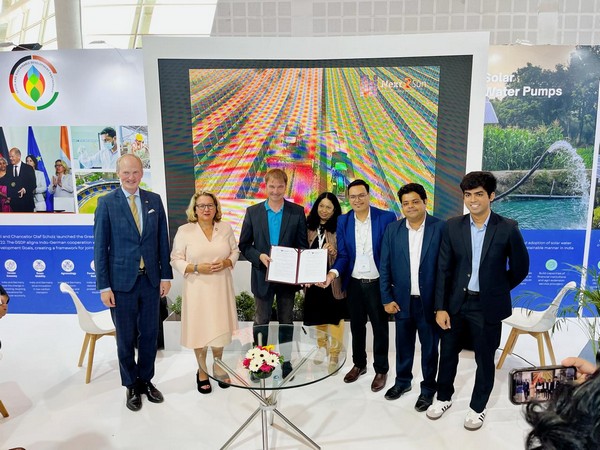New Delhi [India], September 19 (ANI): A Memorandum of Understanding (MoU) was signed between AgriVijay, Next2Sun Germany, and Wattkraft India during the just concluded RE-INVEST 2024, aimed at groundbreaking transformation in renewable energy.
Gujarat hosted the 4th RE-INVEST Global Renewable Energy Meet and Expo (RE-INVEST), organized by the Ministry of New and Renewable Energy (MNRE) this week.
This partnership introduces an innovative vertical solar technology that promises not only to generate clean energy but also to revolutionize the agricultural landscape by enabling continued farming on the same land.
The dual-use approach is expected to transform India’s agrarian economy while making substantial strides towards energy independence and climate action.
“This partnership aims to address the growing concerns over land usage in conventional solar installations, which often displace valuable agricultural land. By implementing Next2Sun’s innovative vertical bifacial Agri-PV systems, we will enable dual land use–allowing farmers to continue agricultural activities while also generating renewable energy,” said Vimal Panjwani, Founder and CEO of AgriVijay.
“With the support of governments and agricultural associations in both India and Germany, our goal is to launch pilot projects across India, with plans to scale this sustainable technology for nationwide adoption,” said Panjwani.
This initiative comes at a critical time, as India seeks innovative ways to meet its growing energy needs without compromising its agricultural strength.
The introduction of Next2Sun’s vertical bifacial solar technology tackles a key challenge faced by traditional solar farms, which often require vast areas of land–land that could otherwise be used for agriculture.
This unique approach allows solar panels to be installed in a vertical orientation, generating energy from both sides while maintaining the ability for farmers to cultivate crops below.
The pilot projects, which will range from 100 kWp to 500 kWp, are designed to showcase the effectiveness of vertical bifacial solar technology across different regions in India.
The MoU signing was witnessed by several key dignitaries, including Sascha Krause-Tunker, CFO of Next2Sun AG, alongside Svenja Schulze, the German Federal Minister for Economic Cooperation and Development.
“With the support of both governments and the agricultural community, we are confident that these projects will set a new benchmark for sustainable development in India. We believe this will inspire others to adopt similar solutions and transform how we think about land use and energy production,” added Sascha Krause-Tunker, emphasizing the far-reaching impact of the partnership.
At COP26 held in 2021, India committed to an ambitious five-part “Panchamrit” pledge. They included reaching 500 GW of non-fossil electricity capacity, generating half of all energy requirements from renewables, and reducing emissions by 1 billion tonnes by 2030. India as a whole also aims to reduce the emissions intensity of GDP by 45 per cent. Finally, India commits to net-zero emissions by 2070.
India meets a sizable portion of its energy needs through fossil fuels, and various renewable energy sources, are seen as an avenue to reduce the dependence on conventional sources of power. (ANI)
Disclaimer: This story is auto-generated from a syndicated feed of ANI; only the image & headline may have been reworked by News Services Division of World News Network Inc Ltd and Palghar News and Pune News and World News
HINDI, MARATHI, GUJARATI, TAMIL, TELUGU, BENGALI, KANNADA, ORIYA, PUNJABI, URDU, MALAYALAM
For more details and packages











